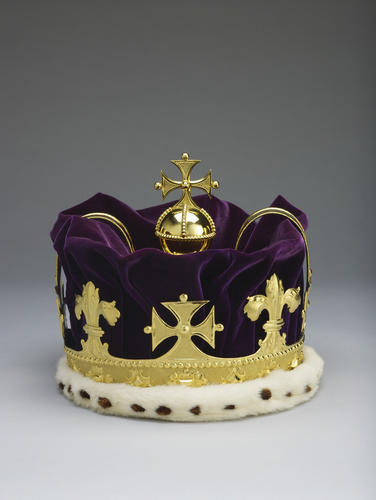-
1 of 253523 objects
The Prince of Wales's Coronet 1728
Gold, velvet and ermine | 20.4 cm (whole object) | RCIN 31709
-
A gold coronet, the band decorated with embossed jewel-like lozenges and ovals with foliate surrounds, on a matted ground, between rows of gold pearls. Above the band are four gold crosses-pattée and four fleurs-de-lis, partly matted and chased. The single arch dips deeply in the centre and supports a monde with gold pearls and a cross above. Fitted with a purple velvet cap and ermine band. The form of the coronet to be worn by the heir apparent to the Crown (usually the Prince of Wales) was decided in a warrant issued in 1677 by Charles II. It was laid down that the coronet would be composed of crosses and fleurs-de-lis, with one arch, and a monde and cross in the centre. In the event, George I was the first post-Restoration monarch whose son survived to adulthood and George (later George II) was created Prince of Wales in 1714. At the coronation the following year, the Prince wore a coronet adorned with pearls and diamonds, although this piece does not survive. George II's own son, Frederick, was not present at his father's coronation in 1727, and was only created Prince of Wales in 1729, although a coronet had already been ordered for him the year before. It is not clear that the coronet was much worn by Frederick, although it does appear in a portrait of him, painted in 1742 attributed to Joseph Highmore (RCIN 404593), and it was carried before the Prince when he attended the State opening of Parliament. This practice was continued for subsequent Princes of Wales, until 1901 when a new Prince's coronet was commissioned for the coronation ceremony of Edward VII.
Provenance
Made for Frederick, Prince of Wales, in 1728.
-
Medium and techniques
Gold, velvet and ermine
Measurements
20.4 cm (whole object)
19.8 cm (at base of object)
930.0 g (Weight) (whole object)
Category
